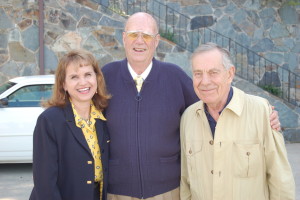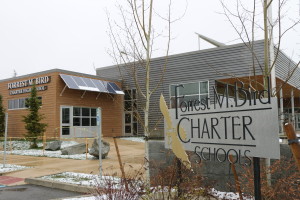Who is Forrest Bird and why is he the namesake of a North Idaho charter school?
Journalist Morley Safer compared Bird to Forrest Gump in a “60 Minutes” piece published six years ago.

Like the fictional character, Bird has met presidents, fought in a war and is responsible for saving thousands of lives.
But Idaho’s Bird is far more accomplished than his Hollywood comparison. Bird is a pilot, doctor and inventor. He’s a veteran, philanthropist and author.
When the Sandpoint charter school changed its moniker to the Forrest M. Bird Charter School in 2010, it was an effort to make sure Bird was not forgotten in Idaho history.
Principal Alan Millar knew of Bird’s accomplishments and is a fan of his wife, Pam Bird, who also owns a lengthy and impressive resume. Millar also was aware his staff and students had benefited from participating in an annual young inventors’ camp at the Bird Aviation Museum and Invention Center museum every summer.
Bird at first hated the idea of a school taking on his name. His main reason: “Schools are named after dead people and I don’t want to die.” He also said a school should be named after “anyone who has done important things.”
It took years, but eventually Bird agreed.
“The Birds were in Paris where Forrest had won some kind of award and they called me from the Eiffel Tower to approve of the name change,” Millar said.
Pam Bird has spoken at each of the three graduations at Forrest Bird Charter School and Forrest has attended. She also has spoken in classes and sent many of their friends to the school to speak to students. Forrest has landed his helicopter at the school a few times.
“This is really all about leaving a legacy,” Millar said. “We have and want students to ask, ‘Who is this Forrest Bird guy?’ I hope that his accomplishments to make the world a better place will inspire a student to be like him.”
Who is Forrest Bird?
Bird, 93, was born in 1921 in Stroughton, Mass., the son of a World War I flying ace. With the encouragement of his father, Bird, who graduated from high school at age 14, also that year soloed in his 1928 Waco biplane. He still owns a plane just like his first one — along with 20 other aircraft.
One story Safer shared on “60 Minutes” was that of a grownup conversation between an 8-year-old Bird and Henry Ford. The founder of the Ford Motor Company was attending a party hosted by the Birds and made a point to track down Forrest.
“Mr. Ford had heard what I had done to one of his Model A engines,” Bird said. “I’d spent $2.50 on a belt that I attached from a Ford engine to my homemade tractor to help farmers process corn. Mr. Ford acted like he wasn’t pleased with this use of his engine and told me that my invention ‘might interfere’ with people buying his automobiles.”

The young Bird fired back that if Ford would lower the price of his cars to make them more affordable, he wouldn’t have anything to worry about.
One of Bird’s proudest moments was meeting Orville Wright, shaking hands and exchanging pleasantries at the 1937 Cleveland Air Show. “I thought he was God,” said a still smitten Bird.
On May 6, 1937, Bird was piloting an airplane when he saw a historical sight. “I banked the plane and all I could see was the Hindenburg in front of me,” he said. “It was magnificent and I spent some time flying around it to take it all in.”
Later that day, the Hindenburg would explode over Lakehurst, N.J.
Bird the inventor
Most would say meeting Henry Ford, Orville Wright and flying with Howard Hughes would be enough peak experiences for a lifetime. Yet these encounters barely begin the story of a man whose life has touched thousands he will never know.
In 1941, Bird was called to active duty as an air-training officer in the U.S. Army Air Corps. During World War II he was certified to fly every aircraft in the armed services inventory. He was one of the heroic pilots who flew over the Burma Hump with General George S. Patton and piloted a captured German Junkers 88 during the war.
The Junkers 88 had a feature that was defeating the Allies in the sky – a pressurized cabin allowing German pilots to climb to higher altitudes than American pilots could reach.
Bird met that challenge with his own invention, turning an ordinary tin can into what is now called a demand regulator. American pilots could now fly comfortably at 38,000 feet and keep pace with the Germans.
With his flying prowess, Bird could have spent the rest of his days flying or training pilots. Instead, he decided to attend medical school.
“I’ve always wanted to help people,” he said. “I knew with medicine I could.”
As a doctor, he adapted his demand regulator to help force air into the lungs of ailing patients. The device has since been modified dozens of times and has saved thousands of lives around the world. His “Baby Bird” machine helps premature babies breathe easier by using the same technology Bird created to control cabin pressure in Learjets.
Bird still travels around the world to lecture doctors and to instruct them on how best to use his inventions. One of his friends said Bird is better known in France than he is in the United States.
Bird met and married Pamela Riddle Bird, a successful author who has written more than 70 books, including “Inventing for Dummies.” She’s made a business of discovering the best new inventions and inventors.
She honored her husband by being the driving force behind the Bird Aviation Museum and Invention Center.
The Bird Aviation Museum and Invention Center in North Idaho
Hundreds of vehicles lined the old country road leading to Glengary Bay, on Lake Pend Oreille near Sagle, the day the museum and invention center opened on July 7, 2007.
Neighbors and friends volunteered to direct traffic and acted as museum guides. Local Boy Scouts cooked up hotdogs. Dozens of planes lined Bird’s private airstrip.
The Birds were ushered down to the landing strip as a female voice crackled over the PA system.
Acrobatic world champion Patty Wagstaff asked for permission to land after she performed an aerial stunt show above the more than 1,000 people in attendance.
Forrest and Pam held up 10-foot poles with a ribbon connecting them. While they stood about 15 feet apart, Wagstaff swooped down and cut the ribbon – while flying upside down.
Three famed aviators came to the show: space shuttle astronaut John Grunsfeld, “Flying Tiger” Tex Hill and the original Top Gun, Chris “Boomer” Wilson. These men spent the day signing autographs while sitting next to the inventors of the Cabbage Patch doll and the computer microprocessor.
The 16,000 square-foot museum is chock-full of American history and has attracted thousands of visitors. On the main floor are many of Bird’s airplanes, flight simulators and unusual, collectible automobiles. NASA has donated many of the items and several of Bird’s planes are destined for the Smithsonian Institute. Original patent models for many inventions can also be found here, including the doorknob, the floor mat, Superman original items and Kitty Litter. The museum contains the original computer chip as well as the first patent for the shoe.
The walls hold autographs from many famous people, including Amelia Earhart and Orville Wright. In the Hall of Prototypes, the visitor can follow the progress from one version of Bird’s respirators to another.
“Each inventor helps another inventor invent,” he said. “Each failed prototype is really a success.”
Bird still spends hours at the museum and enjoys jumping in on tours and answering questions. At 6-foot-2 and wearing a lab coat, he isn’t hard to spot among the elementary students.
“I see Forrest light up when the museum is alive with activity,” Pam said. “It’s our hope that just one of these students will take what they’ve seen in the museum and use it as a spark to invent something great.”
One glass exhibit case remains empty. It isn’t filled because Bird is saving room for his best work yet.
“This museum is one of the things I want to leave behind,” he said. “This is a place to learn and explore.”
One of Bird’s earliest memories is his father suggesting he keep a journal of his life. Bird has recorded nearly every day of more than 90 years.
“The journals are unbelievable,” Pam said. “When he rereads something he has done or someone he has met, the memories start flooding out.”
In 1995, he was inducted into the National Inventors Hall of Fame. He is currently the oldest certified helicopter pilot in the world and held every major license for flying or training.
For all of his accomplishments, Forrest Bird — the pilot, doctor and inventor — is a modest man. Many give Pam credit for sharing Forrest’s accomplishments with the world.
“His insatiable curiosity and his ability to attract people are what drive him,” she said. “He will have a great conversation with a kindergartener or a CEO.”
